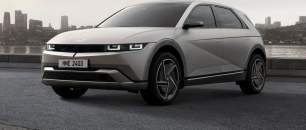In terms of straight line performance we’re talking 0-100km/h in a tick over 5.0 seconds and I see anything in the five-second bracket as properly quick.
With more than 600Nm of peak pulling power at your disposal there’s always plenty of pulling power for efficient in-traffic moves and safe highway overtaking.
The shift-by-wire gear selector on the steering column takes some getting used to but once you’re in tune with it, it’s surprisingly convenient, especially during slow speed parking or turning manoeuvres.
There are multiple modes - ‘Eco’, ‘Normal’, ‘Sport’ and ‘Snow’. Sport mode spices things up a bit with more urgent responses and the ‘HTrac’ AWD system uses multiple sensors to manage potential wheelspin and optimise drive in wet conditions or on loose dirt surfaces.
Suspension is by struts at the front and multi-links and the rear and the Ioniq 5 in this configuration is ultra-smooth and comfortable.
Even hitting pretty aggressive speed bumps and ruts in the road and the car soaks them up without fuss. You’re used to EVs being a little harsh in terms of ride compliance thanks to their relative weight, but that’s not the case here.
As part of a model upgrade introduced earlier this year Hyundai says it undertook a “comprehensive revision to the suspension tune”, which includes high-performance dampers on this N Line. And despite low-ish profile (255/45) Michelin Pilot Sport EV tyres on the 20-inch rims it remains comfortable and quiet.
The upgrade also included body reinforcements in the B- and C-pillar, door surrounds and under the body for a stiffer platform overall.
That pays off in the dynamics. Despite its 2.1-tonne weight the Ioniq 5’s steering is accurate and nicely weighted. It doesn’t feel lumbering or ponderous despite its relative heft.
The physical brakes are ventilated discs front and rear with regenerative available through four levels, the most aggressive setting being ‘i-Pedal’ which allows single-pedal driving.
It will slow the car to a full stop, harvesting the most energy possible in the process, although you might need a dab on the brake pedal if things are tight.
Miscellaneous observations include a 12m turning circle, so be ready for three-point turns where you didn’t think you’d have to.
Hyundai's (and Kia’s) default over-speed warning is present in full-force taking clicks through multiple screens to switch off and avoid its incessant audible alarm saying you've exceed what the car believes is the posted limit (every time you restart the car).
The recently released Tucson Hybrid features a short-cut function to do away with this issue and it would be welcome here.
The CPU underpinning the multimedia system is more powerful and response is speedy without a hint of lag.
And the camera based ‘mirrors’ take some getting used to. For many, they’re the answer to a question no one was asking. I mean, conventional mirrors work pretty well and any aero benefit from the smaller camera units has to be modest. But once you’re in tune with them the hi-def screens are excellent.
A flip of the switch on the interior rear view mirror allows you to side-step tall heads or loads in the back of the car but minimal depth of field is also (visually) awkward at first.

